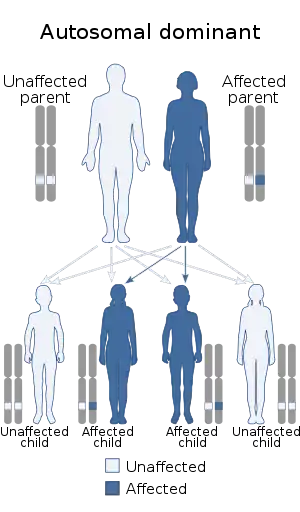Worth syndrome
Worth syndrome, also known as benign form of Worth hyperostosis corticalis generalisata with torus platinus, autosomal dominant osteosclerosis, autosomal dominant endosteal hyperostosis or Worth disease,[1][2] is a rare autosomal dominant congenital disorder that is caused by a mutation in the LRP5 gene.[3] It is characterized by increased bone density and benign bony structures on the palate.[1][3][4][5]
| Worth syndrome | |
|---|---|
 | |
| Worth syndrome has an autosomal dominant pattern of inheritance. |
Causes
Worth syndrome is caused by a mutation in the LRP5 gene, located on human chromosome 11q13.4.[3][6] The disorder is inherited in an autosomal dominant fashion.[1] This indicates that the defective gene responsible for a disorder is located on an autosome (chromosome 11 is an autosome), and only one copy of the defective gene is sufficient to cause the disorder, when inherited from a parent who has the disorder.{{cn}
History
The condition was first reported by H. M. Worth in 1966. In 1977, two doctors, R.J. Gorlin and L. Glass, distinguished the syndrome from van Buchem disease. In 1987 a group of Spanish doctors pointed out that the condition may not be benign, and may sometimes cause nerve damage.[1]
References
- Online Mendelian Inheritance in Man (OMIM): 144750
- Diseases Database (DDB): 32107
- Van Wesenbeeck L, Cleiren E, Gram J, et al. (March 2003). "Six novel missense mutations in the LDL receptor-related protein 5 (LRP5) gene in different conditions with an increased bone density" (Free full text). Am. J. Hum. Genet. 72 (3): 763–771. doi:10.1086/368277. PMC 1180253. PMID 12579474.
- "Worth Syndrome". Retrieved September 12, 2010.
- "Worth's Syndrome". Medcyclopedia. Retrieved September 12, 2010.
- Online Mendelian Inheritance in Man (OMIM): 603506
External links
| Classification | |
|---|---|
| External resources |